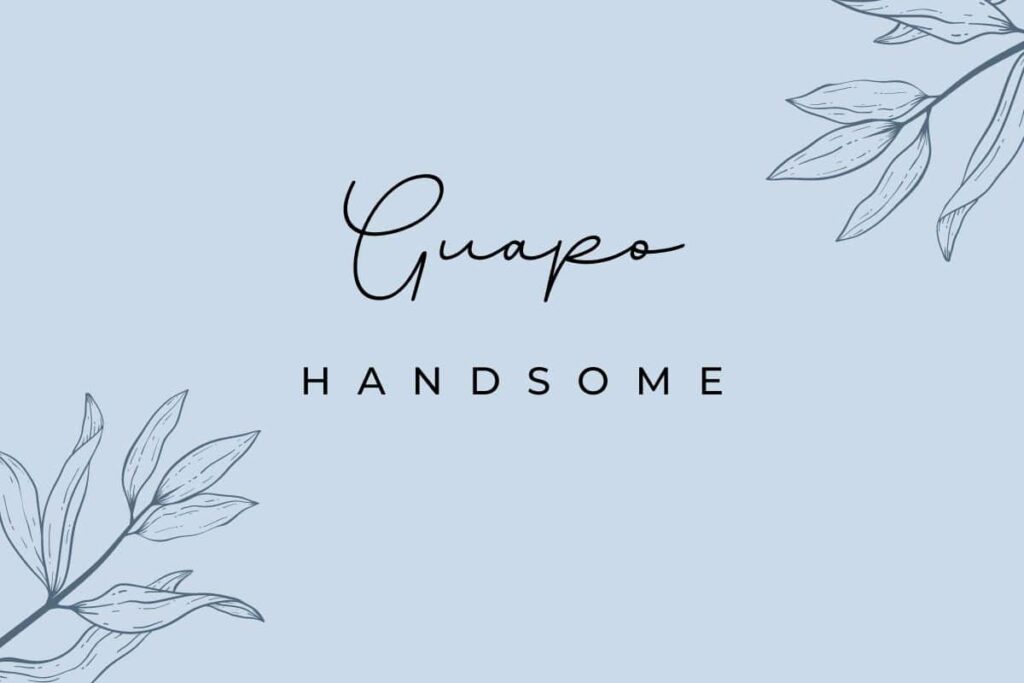20 Fun and Flirty Ways to Say Handsome in Spanish
Have you ever walked around the streets of a Spanish-speaking country, seen an attractive man, and wondered how to tell your friends that you saw someone very handsome in Spanish? Well, if you have experienced this (and if you haven’t yet, you definitely will if you go to Spain or Latin America), we’ve got 20 fun ways for saying handsome in Spanish.
Here, we will talk about the common, flirty, and funny expressions you can use when you refer to a good-looking man in Spanish in every possible context.
Handsome in Spanish at a Glance
Spanish | English |
Handsome | |
Handsome (formal) | |
Beautiful | |
Handsome (neutral) | |
Handsome (neutral) | |
Beautiful | |
Attractive | |
Handsome (respectful) | |
Good-looking (respectful) | |
Charming | |
An Adonis, handsome man | |
Handsome (seductive) | |
A hottie, a "snack" | |
Handsome (slang) | |
Handsome, hot (slang) | |
To be good looking | |
A good-looking man | |
To have handsome features | |
To be good-looking/hot (slang) | |
To be hot (slang) |
All the Ways to Say Handsome in Spanish

Guapo
If you ask someone how to say “handsome” in Spanish, guapo is the first answer they will probably give you. In Spanish, we use guapo as an adjective with the verbs ser and estar depending on the temporary or permanent state.
For example, we might say that a man we see on the streets es guapo. This refers to the permanent state, as in, the man, in general, is handsome. However, if we run into someone we know and want to express that today he looks particularly handsome, we might prefer to say está guapo, because it is a temporary state. You are referring to him specifically in a point in time.
We can also use it with a verb like verse, which means “to look”. For example, we could say: Juan se ve guapo (“Juan looks handsome”). Like estar, verse is a verb that emphasizes a temporary state.
We can also use it in exclamatory sentences with qué + guapo + ser/estar (conjugated) + name or pronoun of the person. One example could be: ¡Qué guapo es Juan! (Juan is so handsome!).
Spanish
- Carlos es guapo.
- Carlos está guapo.
- Juan se ve guapo.
- ¡Qué guapo es/está Juan!
English
- Pedro is handsome (permanent)
- Pedro is handsome (temporary)
- Juan looks handsome
- Juan is so handsome!
We could also grade the word guapo with adverbs like muy (really) or by adding the suffix –ísimo at the end to make it guapísimo, which means “so handsome”.
Apuesto
The second word we will use to call a man handsome is apuesto . This is a word you might have already heard on TV shows, movies or even in your life to refer to a handsome man in Spanish.
Apuesto is an adjective that is mostly used in rather formal conversations, since it’s a more elegant word that refers to a man that seems to be well put together and has a good presence. Since it is an adjective, we use it in the same way as guapo. For example:
Spanish
- Pedro es apuesto.
- Pedro está apuesto.
- Pedro se ve apuesto.
- ¡Qué apuesto es/está Pedro!
English
- Pedro is handsome
- Pedro is handsome
- Pedro looks handsome
- Pedro is so handsome!
Moreover, we can empnasize it by adding muy, just like guapo, but in the case of apuesto, we don’t generally add the suffix -ísimo to it.
Bello
Bello is another way to call a man handsome. It actually means “beautiful“, but it is usually used to talk about someone who is handsome, in particular, to refer to babies or kids.
Since bello is another adjective, we can use it in the same way as the two previous adjectives. Furthermore, we can grade it with muy, and can also add the suffix -ísimo to it. Let’s see a few examples:
Spanish
- Tu hijo es muy bello.
- Tu hijo está bellísimo.
- Tu hijo se ve bellísimo.
- ¡Qué bello está tu hijo!
English
- Your son is very handsome
- Your son is very handsome
- Your son looks very handsome
- How handsome is your son!
Lindo
Lindo is another adjective that can be used to mean that someone is handsome. It actually means “pretty” and it can be used to say that someone is handsome objectively, but it doesn’t necessarily entail attraction.
We can also use it with ser, estar, verse and in exclamatory sentences, and we can also grade it with the adverb muy and the suffix -ísimo:
Spanish
- El vecino es lindísimo.
- El vecino está muy lindo.
- El vecino se ve lindo.
- ¡Qué lindo es el vecino!
English
- The neighbor is very handsome
- The neighbor is very handsome
- The neighbor looks handsome
- How handsome is the neighbor!
Bonito
Bonito is pretty similar to lindo. It is also a rather objective or neutral option for when you recognize that the other person is good-looking, but don’t feel attracted to them and it can mean something similar to “cute”. This is another adjective, so we can also add muy before it, but we don’t usually add the suffix -ísimo to this adjective. Let’s see some examples:
Spanish
- Ese chico es muy bonito.
- Ese chico está bonito.
- Ese chico se ve bonito.
- ¡Qué bonito es ese chico!
English
- That guy is very cute
- That guy is cute
- That guy looks cute
- How cute is that guy!
Hermoso
Hermoso means “extremely beautiful”. For that reason, it is similar to lindo and bonito, but hermoso is generally used more to talk about women than men. In fact, when we use hermoso to talk about a man, we generally mean that he has beautiful features.
We can use hermoso with verbs ser, estar, verse, and in exclamatory sentences and we can add the adverb muy or the suffix –ísimo to it. Here are some examples:
Spanish
- Leandro es hermoso
- Leandro está muy hermoso.
- Leandro se ve hermosísimo.
- ¡Qué hermoso está Leandro!
English
- Leandro is beautiful
- Leandro is very beautiful
- Leandro looks very beautiful
- How beautiful is Leandro!
Read next: What does hermosa mean and how do you use it?
Atractivo
Atractivo literally means “attractive”. And just like the word “attractive” in English, this word can be used in formal contexts or in an impersonal way, acknowledging that a man is attractive, but not implying much more than that.
We can grade it with muy and use it with verbs ser, estar, verse and in exclamatory sentences. However, we can’t use the suffix -ísimo with this adjective.
Spanish
- Pablo es atractivo.
- Pablo está atractivo.
- Pablo se ve muy atractivo.
- ¡Qué atractivo es Pablo!
English
- Pablo is attractive
- Pablo is attractive
- Pablo looks very attractive
- How attractive is Pablo!
Buen Mozo
In formal contexts, we can call a man buen mozo when they are not only handsome, but also have a pleasant personality and a nice body. Since it is a rather formal word, we don’t usually use it to refer to any man or boy we know, but people we usually respect as well.
Even though it is a phrase, we use it as an adjective, so we can use it with the verb ser and in exclamatory sentences. However, since we usually use it to talk about men who are always handsome, pleasant, and respected, we don’t generally use it with the verbs estar and verse.
We can add the adverb muy before it, but cannot be made a superlative by adding -ísimo.
Spanish
- Mi jefe es muy buen mozo.
- ¡Qué buen mozo es mi jefe!
English
- My boss is very handsome
- How handsome is my boss!
Bien Parecido
Bien parecido means “good-looking” and is used in a similar way to buen mozo. It is also a formal word, but this one is used only to mean that the man we’re talking about is handsome but not that we feel attracted to them. Actually, we generally use it with people who are older than us or people we respect.
We can use it with the verbs ser and in exclamatory sentences and we can intensify it with the adverb muy.
Spanish
- El director es muy bien parecido.
- ¡Qué bien parecido es el director!
English
- The director is very good looking
- How good looking is the director!
Agraciado
Agraciado can be a bit tricky because we usually use it to talk about a person who has a characteristic that makes him good-looking, but not necessarily handsome. It means that there is something about that person that makes him graceful, charming, or attractive. That something can be his walk, his talk, his attitude, his clothes…
We don’t usually use this adjective with verbs like estar and verse that are used for temporary states, but we can use it in exclamatory sentences and with ser. We can add muy before the word and the suffix –ísimo at the end of the word to grade it.
Spanish
- Tu primo es muy agraciado.
- ¡Qué agraciado es tu primo!
English
- You cousin is very graceful/charming
- How graceful/charming is your cousin
Un Adonis
In Greek mythology, Adonis was Aphrodite’s lover and represents a man who is notoriously handsome. For this reason, in Spanish, we use the phrase un adonis to refer to a man that is extremely good-looking.
Out of the verbs we’ve seen, we usually use it only with the verb ser and we cannot use it with the adverb muy nor add the suffix -ísimo to it. Let’s see an example:
Spanish
Tu novio es un Adonis.
English
Your boyfriend is a good-looking man.
We can, however, add other intensifiers like verdadero (real) or realmente (really). Let’s see them in examples:
Spanish
- Tu novio es un verdadero Adonis.
- Tu novio es realmente un Adonis.
English
- Your boyfriend is a really good-looking man
- Your boyfriend really is a good-looking man
Galán
Galán is used to refer to a man that is attractive or even seductive. It is generally used as a noun in the place of names or term of endearment. For example:
Spanish
Hola, galán, ¿cómo dormiste?
English
Hey, handsome, how did you sleep?
As a noun, we can also use it in a similar way to Adonis, with the article un before it and the verb ser:
Spanish
Ese actor es un galán.
English
That actor is a handsome man
We can add the augmentative suffix -azo to the end of the word to make it into galanazo. And we can also use intensifiers like verdadero and realmente:
Spanish
- Ese actor es un galanazo.
- Ese actor es un verdadero galán.
- Ese actor es realmente un galán.
English
- That actor is really handsome
- That actor is a really handsome man
- That actor really is a handsome man
Additionally, we can use it as an adjective in exclamatory sentences with the verbs ser or estar:
Spanish
¡Qué galán está ese actor!
English
How handsome is that actor!
Churro
You probably know churros are a Latin American snack, but this word can also be used to talk about handsome men in a very informal way! Churro is used as an adjective in some Latin American countries, like Colombia and Peru, to mean, precisely, that a man is a “snack”, a hottie.
As other adjectives we’ve seen, we can use it with the verbs ser, estar, verse and in exclamatory sentences. And we can also grade it with the adverb muy and intensify it with the suffix -ísimo. Let’s see some examples:
Spanish
- Joaquín es muy churro.
- Joaquín está churrísimo.
- Joaquín se ve churro.
- Qué churro está Joaquín!
English
- Joaquín is really hot
- Joaquín is really hot
- Joaquín looks hot
- How hot is Joaquín!
Keep in mind that this is a slang word used only in some countries, so we can only use it in some informal contexts.
Chulo
Chulo is another slang word used in some countries like Ecuador, Mexico, Guatemala, Honduras and Puerto Rico. It is an informal word that means “handsome”, “good-looking”, or even “cute”.
We use it as an adjective in sentences with the verbs ser, estar, verse and in exclamatory sentences. And we can also intensify it with the adverb muy and the suffix -ísimo.
Spanish
- El profesor es chulo, ¿verdad?
- El profesor está muy chulo, ¿verdad?
- El profesor se ve chulísimo, ¿verdad?
- ¡Qué chulo es el profesor!
English
- The teacher is handsome, right?
- The teacher is very handsome, right?
- The teacher looks very handsome, right?
- How handsome is the teacher!
Papacito
In some Latin American countries, another slang word to refer to a handsome, attractive, or hot man is papacito . I’m sure you must have heard it in a song, a TV show or a movie because this word (as well as its female counterpart, mamacita) is rather popular.
Papacito is an informal noun that we can use with the article un and the verb ser or in exclamatory sentences:
Spanish
- Ernesto es un papacito
- ¡Qué papacito es Ernesto!
English
- Ernesto is a hottie
- How hot is Ernesto!
We can also use this word without the article un as a nickname or pet name to talk to someone. For example:
Spanish
¿Cómo estás, papacito?
English
How are you, hottie?
There are also two variations to this word you might listen to. One of them is the noun papucho and, if we add the magnifying suffix -ote to the root of papacito, we also have papazote. These words can be used in the same way as papacito, but are used in different countries. Let’s see some examples:
Spanish
- Ernesto es un papazote.
- Ernesto es un papucho.
- ¡Qué papazote es Ernesto!
- ¡Qué papucho es Ernesto!
English
- Ernesto is a real hottie
- Ernesto is a hottie
- How hot is Ernesto!
- How hot is Ernesto!
Tener buena pinta
Tener buena pinta is used in some Latin American countries (especially in Colombia) to mean that a man is attractive or good-looking. As you can see, this set phrase is used only with the verb tener conjugated as needed. For example:
Spanish
¿Has visto a ese chico? ¡Tiene buena pinta!
English
Have you seen that guy? He looks good!
We can still intensify the phrase by placing the adverb muy between the verb tener and buena pinta. For example:
Spanish
¿Has visto a ese chico? ¡Tiene muy buena pinta!
English
Have you seen that guy? He looks really good!
Pintoso
Pintoso is similar to tener buena pinta. It is used almost exclusively in Colombia and it means “good-looking man” and has no sexual nor romantic implications. In this case, we’re talking about an adjective that we can use with the verb ser and in exclamatory sentences and that can be intensified with the adverb muy:
Spanish
- Juan es solo mi amigo, pero sé que es muy pintoso.
- ¡Qué pintoso que es mi amigo Juan!
English
- Juan is just my friend, but I know he’s good looking
- How good-looking is my friend Juan
Tener porte
We use the phrase tener porte to talk about a man that has good-looking or attractive characteristics, such as a good height or body. Just like with tener buena pinta, this set phrase is used only with the verb tener conjugated as needed. It can also be intensified with the adjective buen:
Spanish
Ese atleta tiene buen porte, ¿no crees?
English
This athlete has a great body, don’t you think?
Estar como un tren
Estar como un tren is another set phrase, though, this time, we’re talking about an informal one with the verb estar. Its literal translation would be “to be like a train”, but when we use it in Spanish, we mean that a person is extremely attractive. Estar como un tren is used to talk about looks and is a rather straightforward way to talk about someone we find really attractive. Let’s see an example:
Spanish
Ese tío está como un tren.
English
That guy is really hot
Estar bueno
Our last way of referring to someone handsome is with the phrase estar bueno . You may already know bueno as meaning “good” in Spanish, but it can also be used to talk about a man’s physical traits, especially his body, so it means something like “He’s hot”.
Spanish
El cantante de esta banda está bueno.
English
This band’s singer is hot
We can actually intensify this phrase in two ways. We could add the adverb muy between estar and bueno, and we can use the phrase está pasado de bueno, which would mean something like “he’s extremely hot”.
Spanish
- El cantante de esa banda está muy bueno.
- El cantante de esa banda está pasado de bueno.
English
- This band’s singer is really hot.
- This band’s singer is extremely hot.
Key Takeaways
Now that you know more than 20 ways to say that a man is handsome, you can finally use it to talk about men with your friends, to go talk to a handsome man yourself, and even to nickname your boyfriend, husband or any other papacito you may know. Remember the contexts in which you should use each of these words and phrases, so that you don’t make the mistake of telling your friends that a guy you find hot is only bien parecido, or worse, to call your boss churro!






